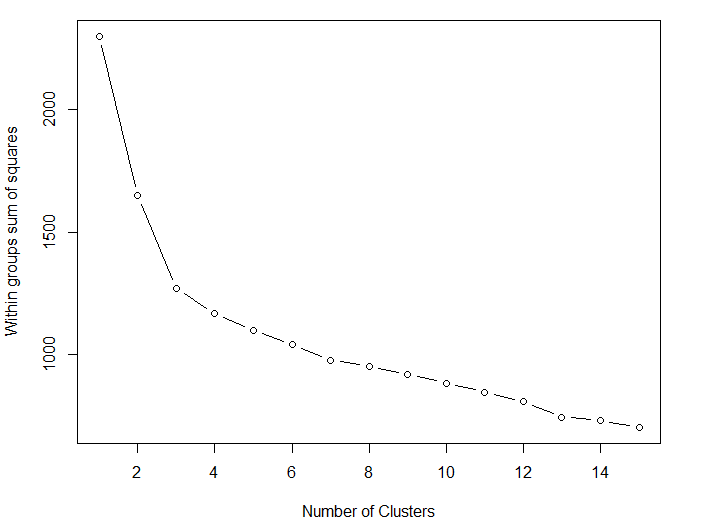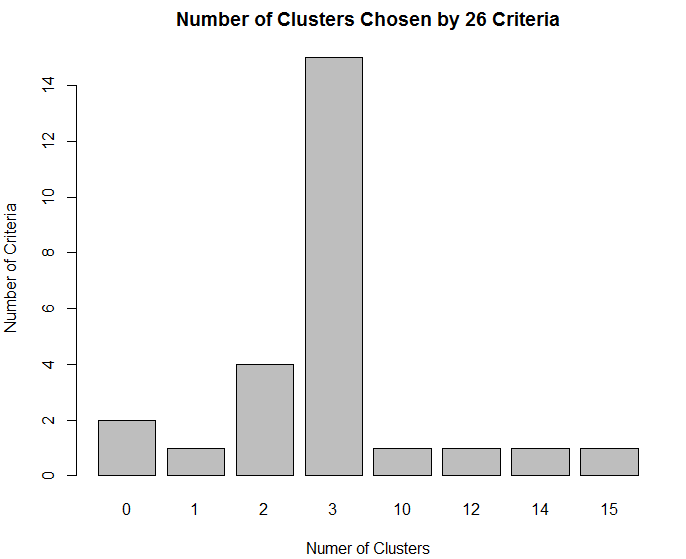- K均值(k-means)算法
a、选择 K 个中心点(随机选择 K 行)
b、把每个数据点分配到离它最近的中心点
c、重新计算每类中的点到类中心距离的平均值(也就是说,得到长度为 p 的 均值向量,这里的 p 是变量的个数)
d、分配每个数据点到它的最近的中心点
f、重复步骤(c)和(d)直到所有的观测值不再分配或是达到最大的迭代次数(R把10次作为默认的迭代次数)
在 R 中把观测值分成 k 组并使得观测值到指定的聚类中心的平方的总和为最小,也就是说在步骤(b)和(d)中,每个观测值被分配到使下式得到最小值的那一类中:

 :表示第 i 个观测值中第 j 个变量的值
:表示第 i 个观测值中第 j 个变量的值
 :表示第 k 个类中第 j 个变量的均值,其中 p 是变量的个数
:表示第 k 个类中第 j 个变量的均值,其中 p 是变量的个数
- kmeans(x,centers)
K均值的函数格式
kmeans(x,centers)x:表示数值的数据集(矩阵或数据框)
centers:要提取的聚类数目
a、函数返回类的成员、类中心、平方和(类内平方和、类间平方和、总平方和)和类大小。
b、K均值距聚类能出处理比层次聚类更大的数据集,观测值不会永远被分到一类中。均值的使用意味着所有的内变量必须是连续的,并且这个方法很有可能被异常值影响。它在非凸聚类(例如 U型)情况下会变的很差
c、由于 K 均值聚类在开始要随机选择 k 个中心点,在每次调用函数时可能获得不同的方案。使用 set.seed()函数可以保证结果是可复制的。此外,聚类方法对初始中心值的选择也很敏感。kmeans()函数有一个nstart选项尝试多种初始配置并输出最好的一个。例如,加上 nstart =25 会生成25个初始配置,通常推荐使用这种方法
d、不像层次聚类方法,K均值要求事先确定要提取的聚类个数,同样, NbClust 包可以作为参考,另外,在 K 均值聚类,类中总的平方值对聚类数量的曲线可能有帮助,可以根据图中的弯曲( 类似与主成分分析中判断成分个数) 选择适当的类型数量
wssplot <- function(data, nc=15, seed=1234){ # data是用来做分析的数据值,nc是要考虑的最大聚类个数 seed是一个随机数种子
wss <- (nrow(data)-1)*sum(apply(data,2,var))
for (i in 2:nc){
set.seed(seed)
wss[i] <- sum(kmeans(data, centers=i)$withinss)}
plot(1:nc, wss, type="b", xlab="Number of Clusters",
ylab="Within groups sum of squares")} 葡萄酒数据的 K均值聚类
> data(wine,package = "rattle") #从包中导入数据
> head(wine)
Type Alcohol Malic Ash Alcalinity Magnesium Phenols Flavanoids Nonflavanoids Proanthocyanins Color Hue Dilution Proline
1 1 14.23 1.71 2.43 15.6 127 2.80 3.06 0.28 2.29 5.64 1.04 3.92 1065
2 1 13.20 1.78 2.14 11.2 100 2.65 2.76 0.26 1.28 4.38 1.05 3.40 1050
3 1 13.16 2.36 2.67 18.6 101 2.80 3.24 0.30 2.81 5.68 1.03 3.17 1185
4 1 14.37 1.95 2.50 16.8 113 3.85 3.49 0.24 2.18 7.80 0.86 3.45 1480
5 1 13.24 2.59 2.87 21.0 118 2.80 2.69 0.39 1.82 4.32 1.04 2.93 735
6 1 14.20 1.76 2.45 15.2 112 3.27 3.39 0.34 1.97 6.75 1.05 2.85 1450
> df <- scale(wine[-1])#-1表示剔除第一行的变量,scale()将观测值标准化
#确定聚类的个数
> wssplot(df) #画图,有点类似碎石检验,用于确定聚类的个数,如下图1
> library(NbClust)
> set.seed(1234)
> nc <- NbClust(df,min.nc = 2,max.nc = 15,method = "kmeans")
*** : The Hubert index is a graphical method of determining the number of clusters.
In the plot of Hubert index, we seek a significant knee that corresponds to a
significant increase of the value of the measure i.e the significant peak in Hubert
index second differences plot.
*** : The D index is a graphical method of determining the number of clusters.
In the plot of D index, we seek a significant knee (the significant peak in Dindex
second differences plot) that corresponds to a significant increase of the value of
the measure.
*******************************************************************
* Among all indices:
* 4 proposed 2 as the best number of clusters
* 15 proposed 3 as the best number of clusters
* 1 proposed 10 as the best number of clusters
* 1 proposed 12 as the best number of clusters
* 1 proposed 14 as the best number of clusters
* 1 proposed 15 as the best number of clusters
***** Conclusion *****
* According to the majority rule, the best number of clusters is 3
*******************************************************************
> par(opar)
Warning messages:
1: In par(opar) : 无法设定图形参数"cin"
2: In par(opar) : 无法设定图形参数"cra"
3: In par(opar) : 无法设定图形参数"csi"
4: In par(opar) : 无法设定图形参数"cxy"
5: In par(opar) : 无法设定图形参数"din"
6: In par(opar) : 无法设定图形参数"page"
> table(nc$Best.n[1,])
0 1 2 3 10 12 14 15
2 1 4 15 1 1 1 1
> barplot(table(nc$Best.n[1,]), xlab="Numer of Clusters", ylab="Number of Criteria",
main="Number of Clusters Chosen by 26 Criteria") #根据图形确定K的个数,如下图2
#进行 K 均值聚类分析
> set.seed(1234)
> fit.km <- kmeans(df,3,nstart = 25) #kmeans K均值聚类分析
> fit.km$size #分成三类,每类的观测值
[1] 51 65 62
> aggregate(wine[-1],by=list(cluster=fit.km$cluster),mean) #计算原始矩阵中每类的变量均值
cluster Alcohol Malic Ash Alcalinity Magnesium Phenols Flavanoids Nonflavanoids Proanthocyanins Color Hue
1 1 13.13412 3.307255 2.417647 21.24118 98.66667 1.683922 0.8188235 0.4519608 1.145882 7.234706 0.6919608
2 2 12.25092 1.897385 2.231231 20.06308 92.73846 2.247692 2.0500000 0.3576923 1.624154 2.973077 1.0627077
3 3 13.67677 1.997903 2.466290 17.46290 107.96774 2.847581 3.0032258 0.2920968 1.922097 5.453548 1.0654839
Dilution Proline
1 1.696667 619.0588
2 2.803385 510.1692
3 3.163387 1100.2258

图1 画出组内的平方和和提取的聚类个数的对比。从一类到三类下降得很快(之后下降的很慢),建议选用聚类个数为 3 的解决方案

图2
K均值可以很好的揭示类型变量中的正在数据结构吗?交叉列表类型(葡萄酒品种)和类成员
> ct.km <- table(wine$Type,fit.km$cluster)
> ct.km
1 2 3
1 0 0 59
2 3 65 3
3 48 0 0使用flexclust包中的兰德指数(Rand index)来量化类型变量和类之间的协议
> library(flexclust)
> randIndex(ct.km)
ARI
0.897495 调整的兰德指数为两种划分了一种衡量两个分区之间的协定,即调整后机会的量度,它的变化范围是从-1(不同意)到1(完全同意)。





















 7147
7147











 被折叠的 条评论
为什么被折叠?
被折叠的 条评论
为什么被折叠?








